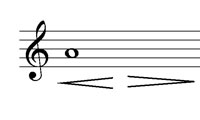Potential in Every Note

The messa di voce is the act of beginning a single pitch softly, making a crescendo, then a diminuendo. It was considered important both as an expressive device and as a training tool in many Old School singing methods. It is found in the method books of Garcia (Hints on Singing #29), Marchesi (exercise #174), Crivelli (exercise #1), Mancini (Pensieri, Articolo IX), Tosi (Observations on the Florid Song, Ch. 1, paragraph 29), and Lamperti (Article VI), among others.
In an article for Strad magazine in 2004, the cellist and Alexander Technique teacher Pedro de Alcantara discussed the “messa di voce” in music in general, and as applied specifically to string playing and singing. This passage in particular resonated with what I have explored for years as “the potential in every note”: “Signalling a virtuosity of contact between player and instrument, or between singer and voice, latent messa di voce is forever present in the ideal technique.”
When a sung tone is poised in such a way that it can change volume, pitch, and vowel with ease, then it can be said to have maximal potential. It can go anywhere. With such potential, singing becomes a delight for both listener and singer. The voice sounds alive and vibrant, and is capable of vast expressive possibilities.
Even if the task at hand is a “wall of sound” passage from Puccini, Wagner, or Jason Robert Brown, singing in such a way that the voice could at any moment break out into a cadenza or a series of messa di voce gestures is desirable. Singing with a multifaceted potential on every note ensures that the muscles will not be locked, breath pressure will not be excessive, stamina will be retained, vibrato will be lively, and vowels will be recognizable. It allows the singer to express themselves more easily musically and dramatically.
How can one find this sort of potential on every sung tone? Training! Functioning chest and head registers must be developed, then exercises that require fast movement, sustaining, and messa di voce dynamics – alone and in combination – are essential. There are myriad exercises that can be found or constructed for these elements. No single exercise or collection of exercises is the Holy Grail of training. The teacher and singer, by using carefully honed listening, must determine what the voice needs. A way must be found to allow any tone to move pitchwise, rhythmically, and/or dynamically without getting stuck in a position. Too many locked, pushed voices are excused from finding the ease which is every singer’s right!
Much current vocal training never addresses how to build extensive dynamic potential. Dynamism is too often conceived of as something added to the voice, rather than ideally being constantly available in every sung tone. There are traces of the idea of constant vocal potential in some singers and genres today, most notably in the more decorative renderings of some R&B and gospel singers. A healthy voice WANTS to break free now and then, and needs to be allowed to do so! The messa di voce can contribute to both agility and strength. Learning how to stay balanced without interfering tensions when moving between loud and soft singing helps pitch and agility as well.
The messa di voce can be approached in small steps. The 8 and 16 beat exercises in some books can be daunting. However, there are great benefits to starting with much shorter notes and gradually extending them.
excellent, thanks, Brian !
this awesome Brian…i loved reading your articles 🙂 Will recommend your guides to me young daughter who recently got taste for singing..
Thanks Marilyn. Best to your daughter on her singing journey.